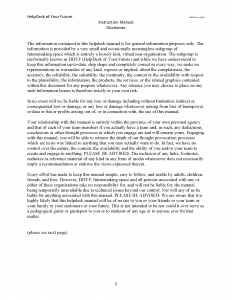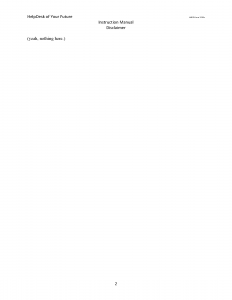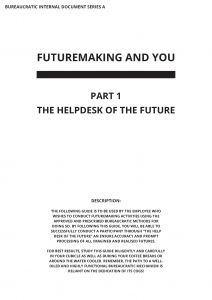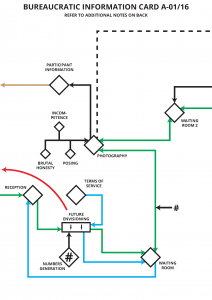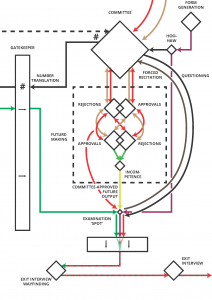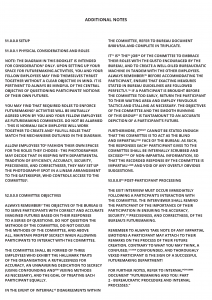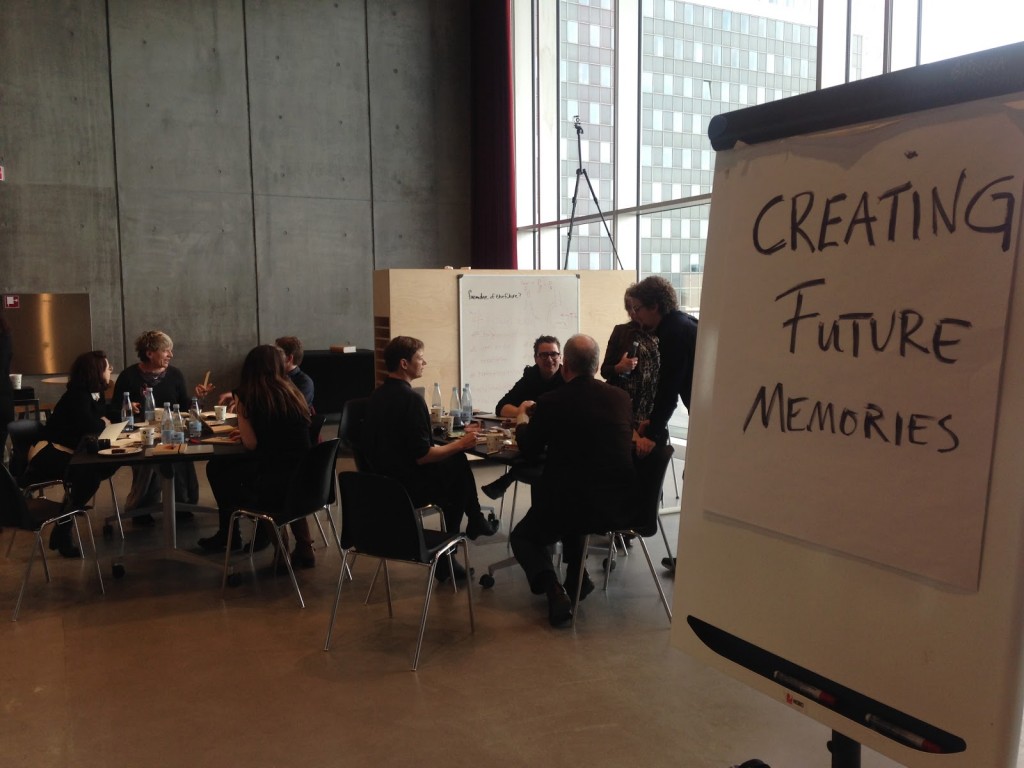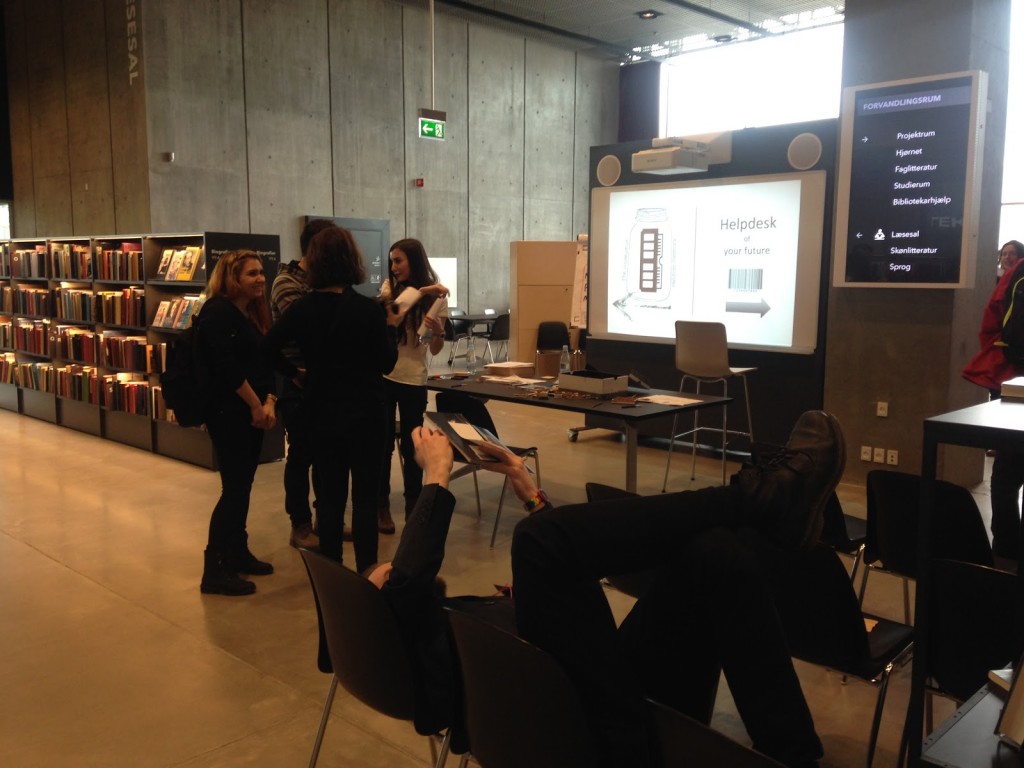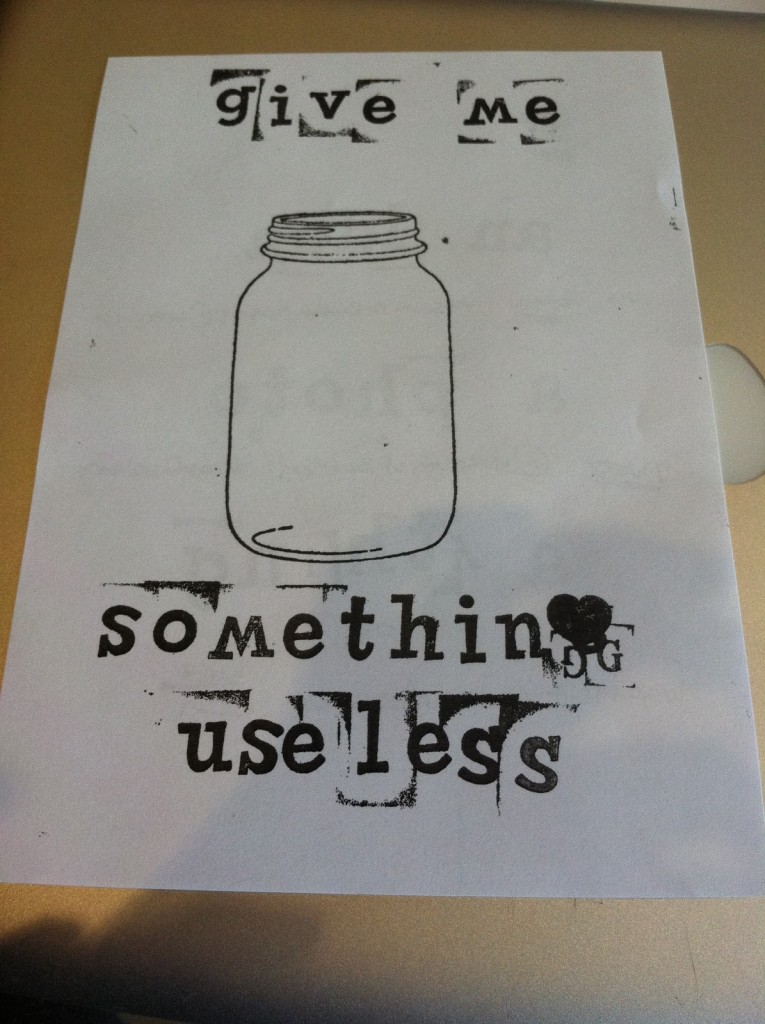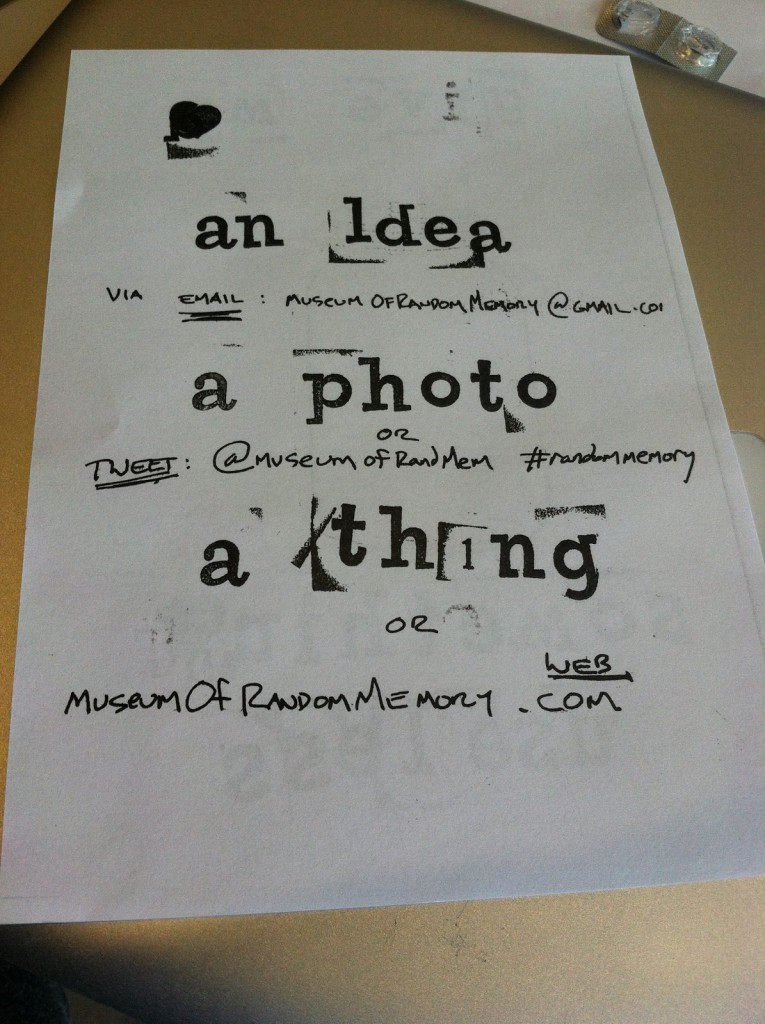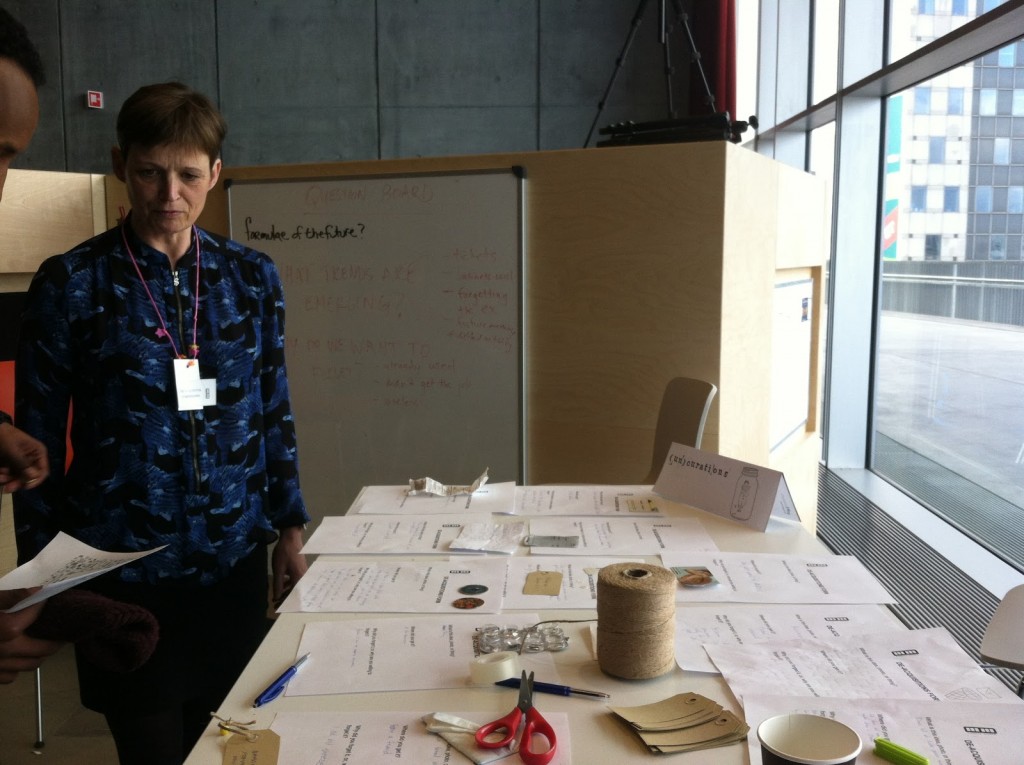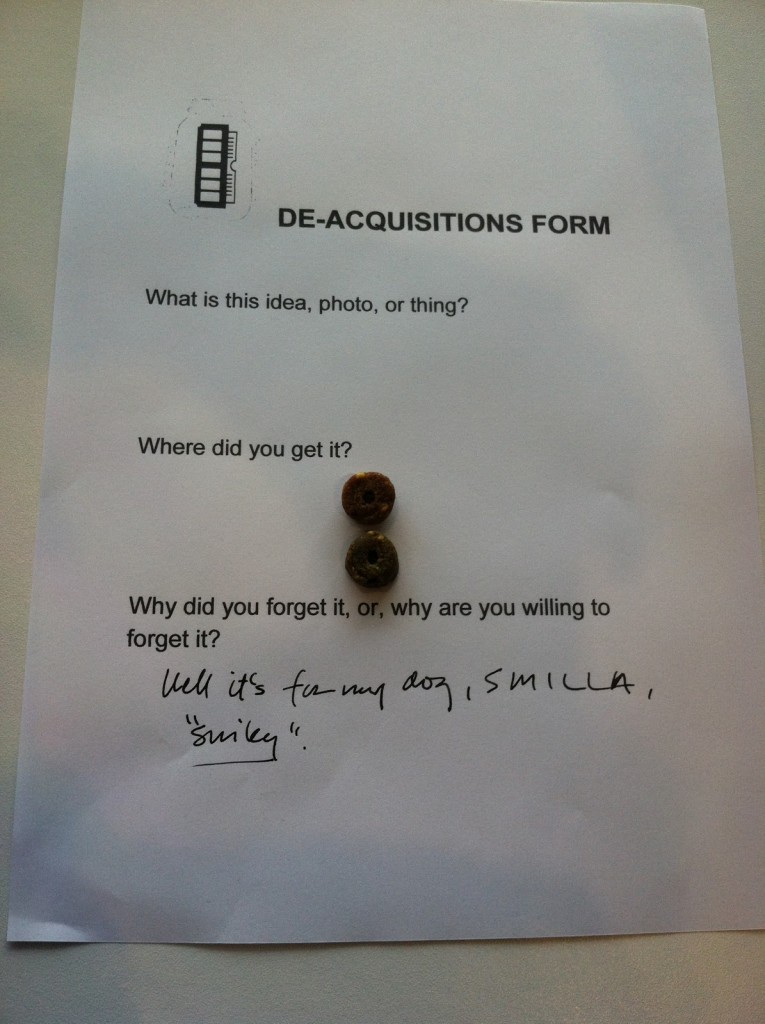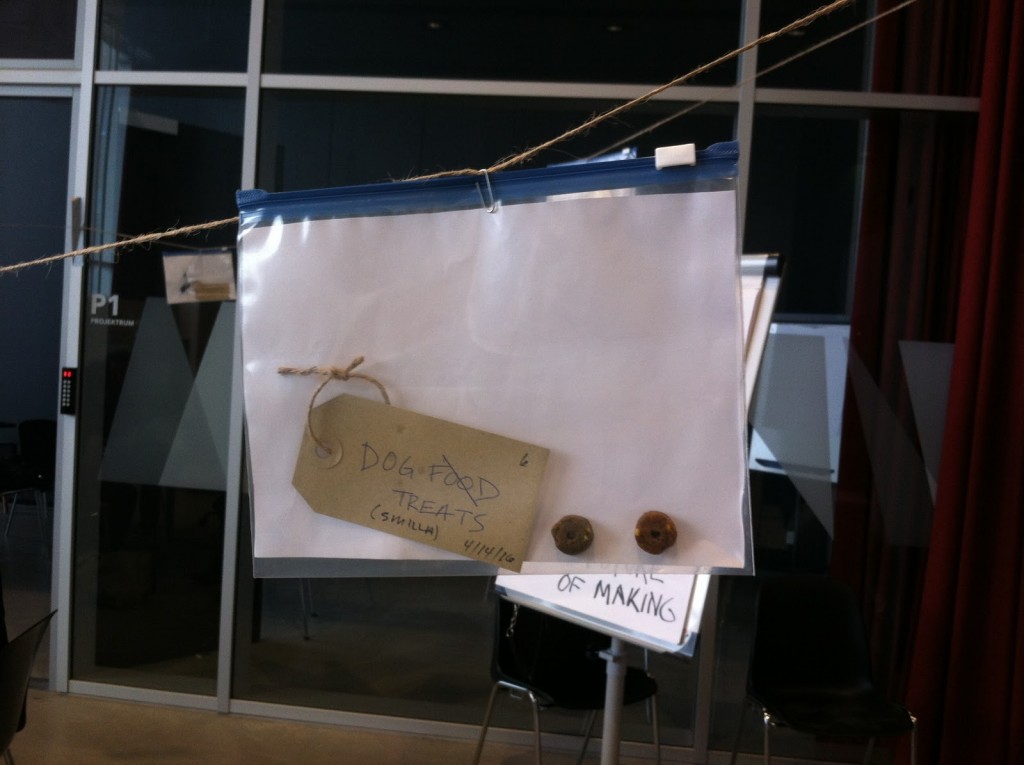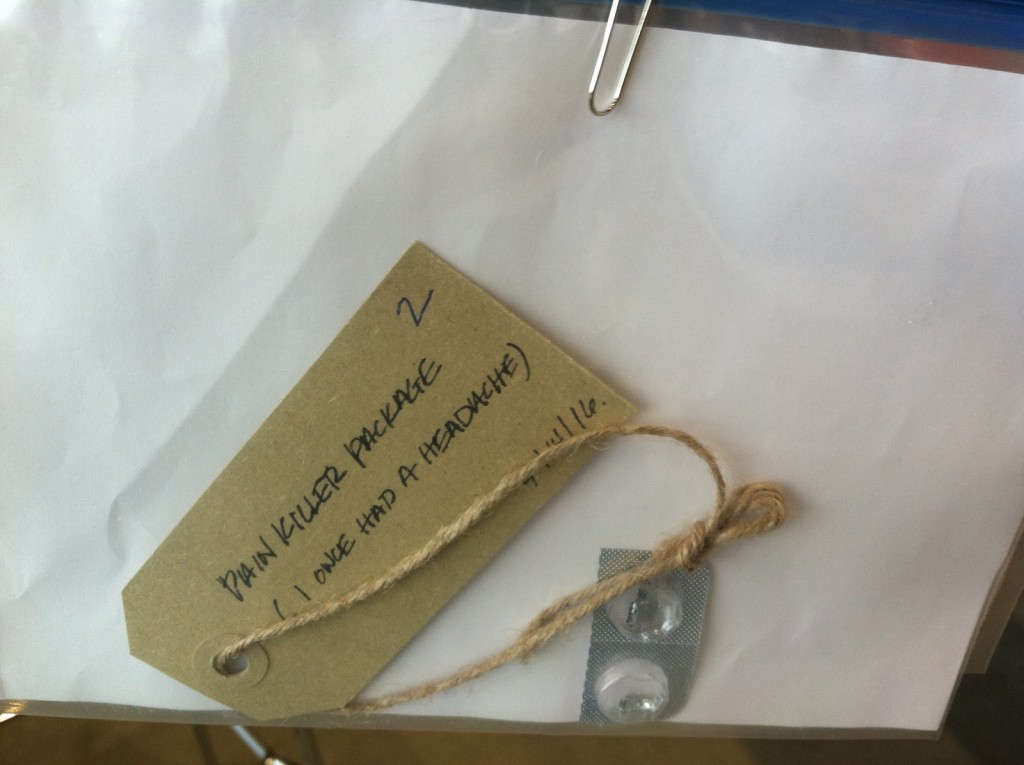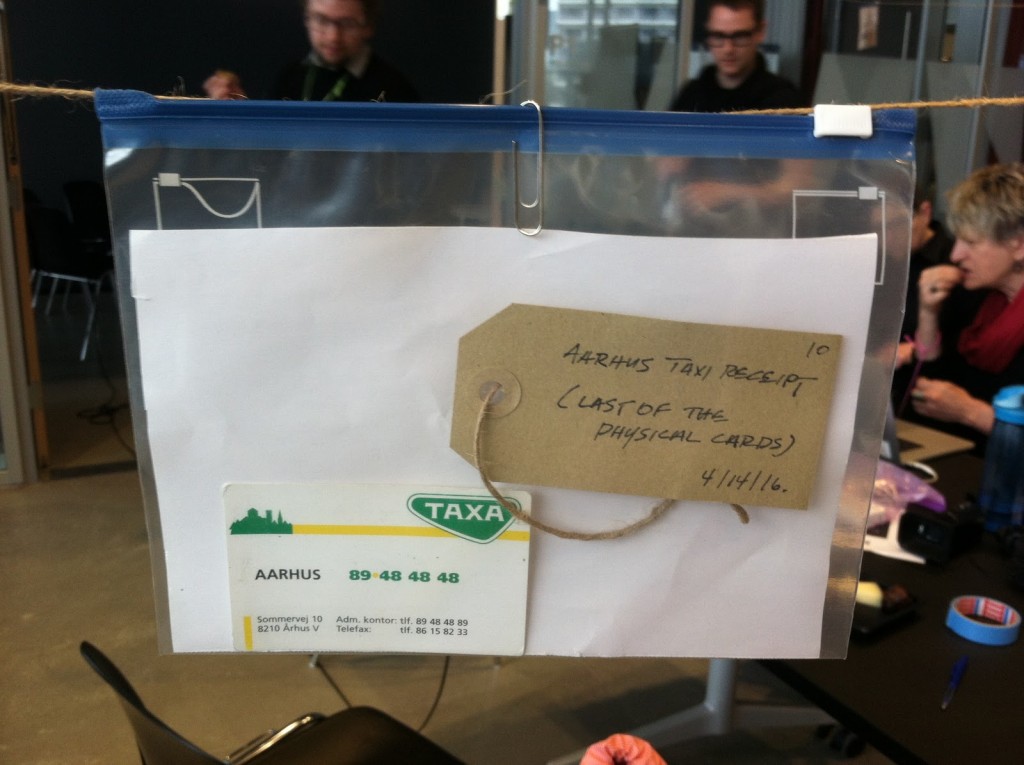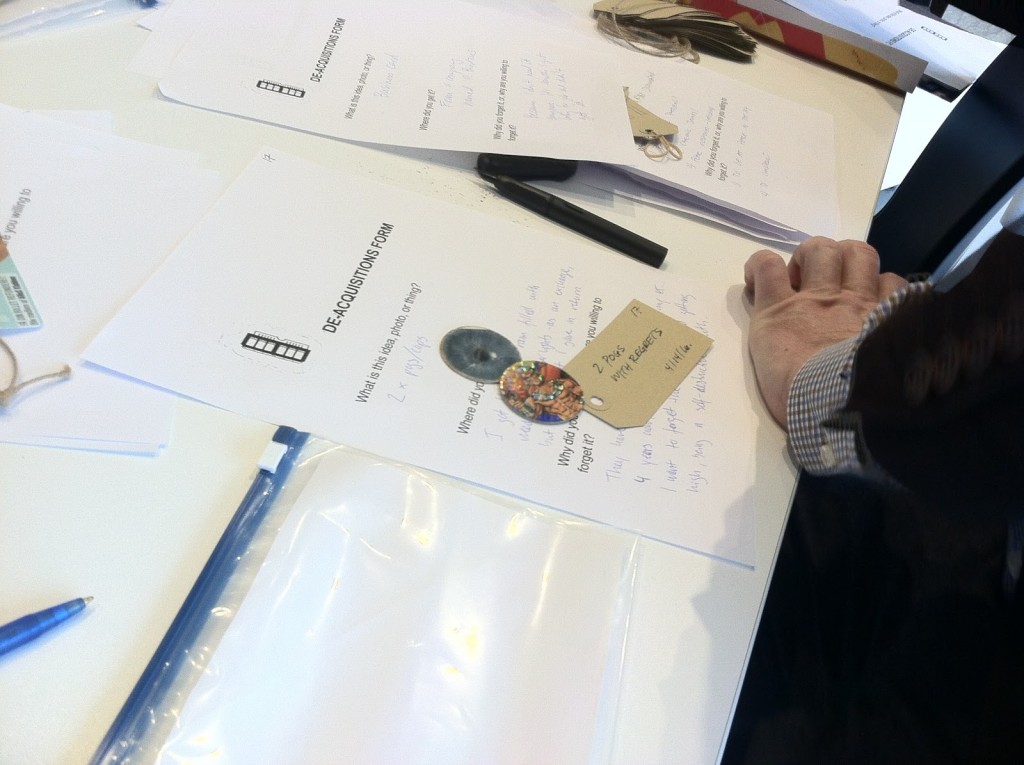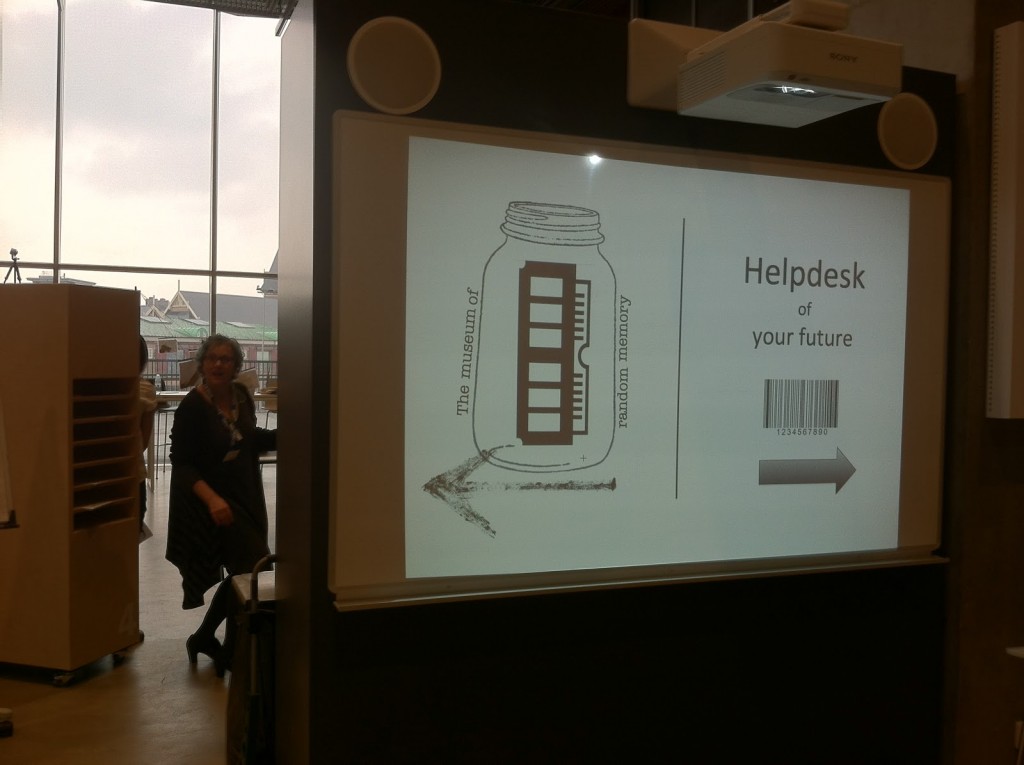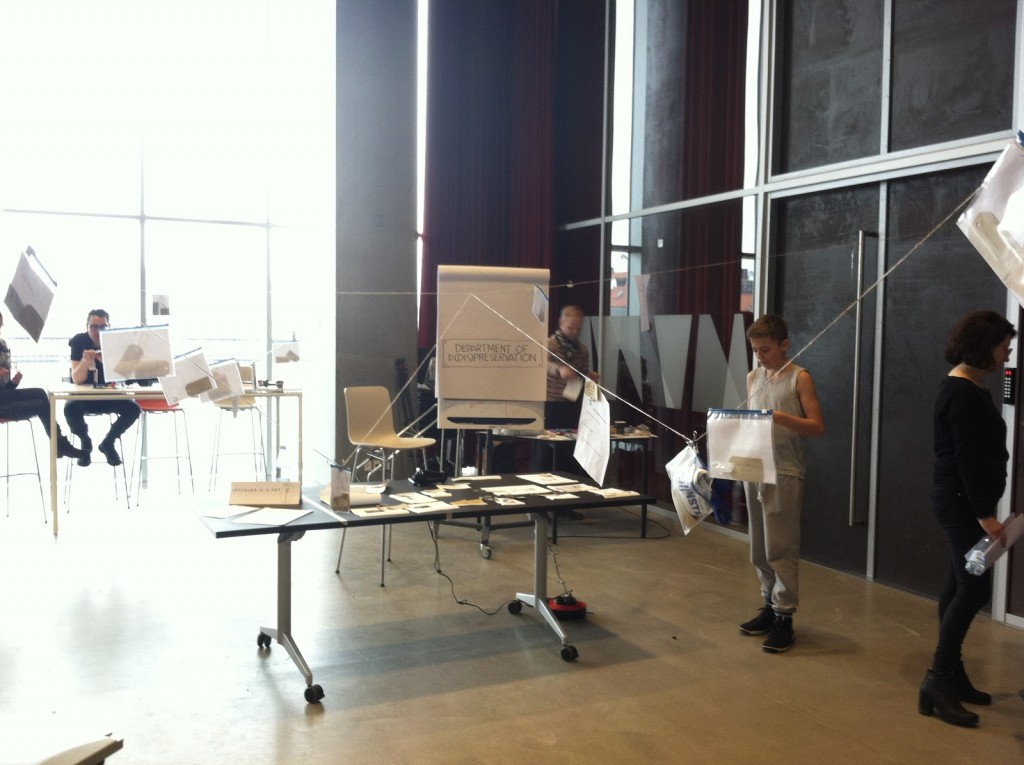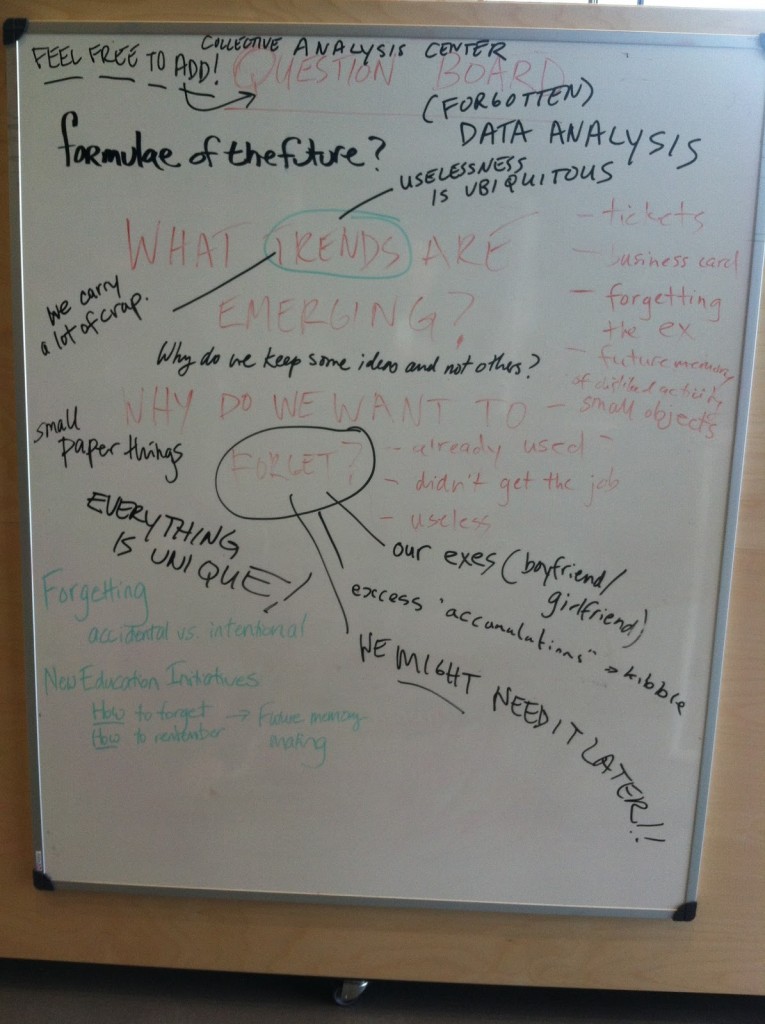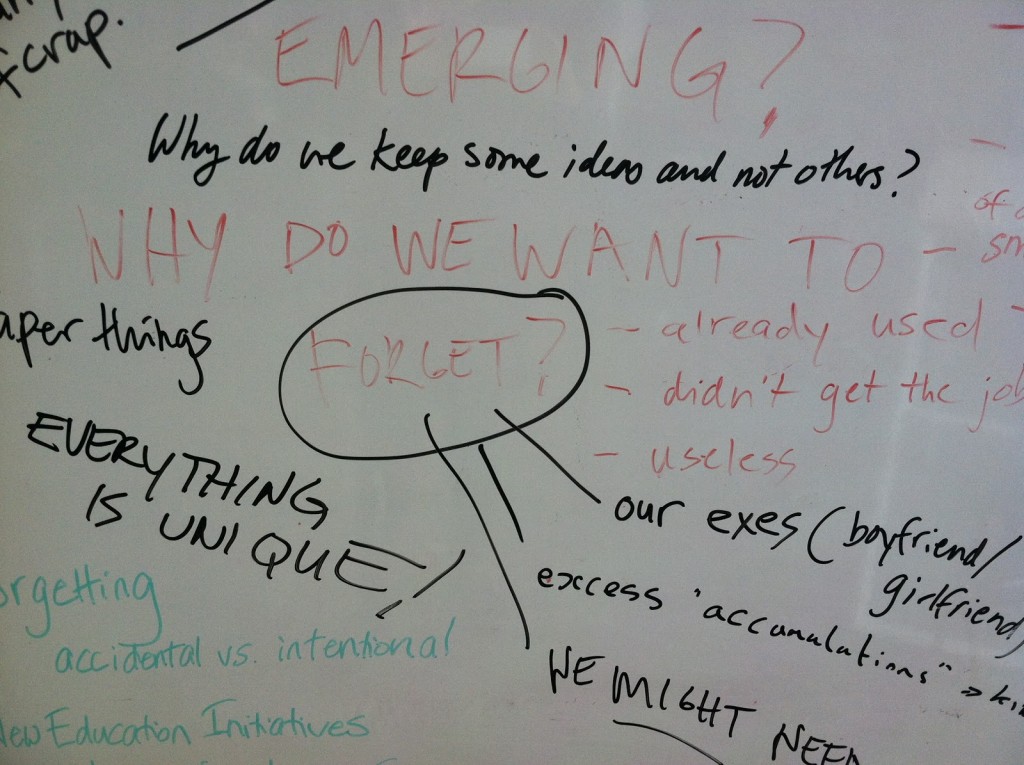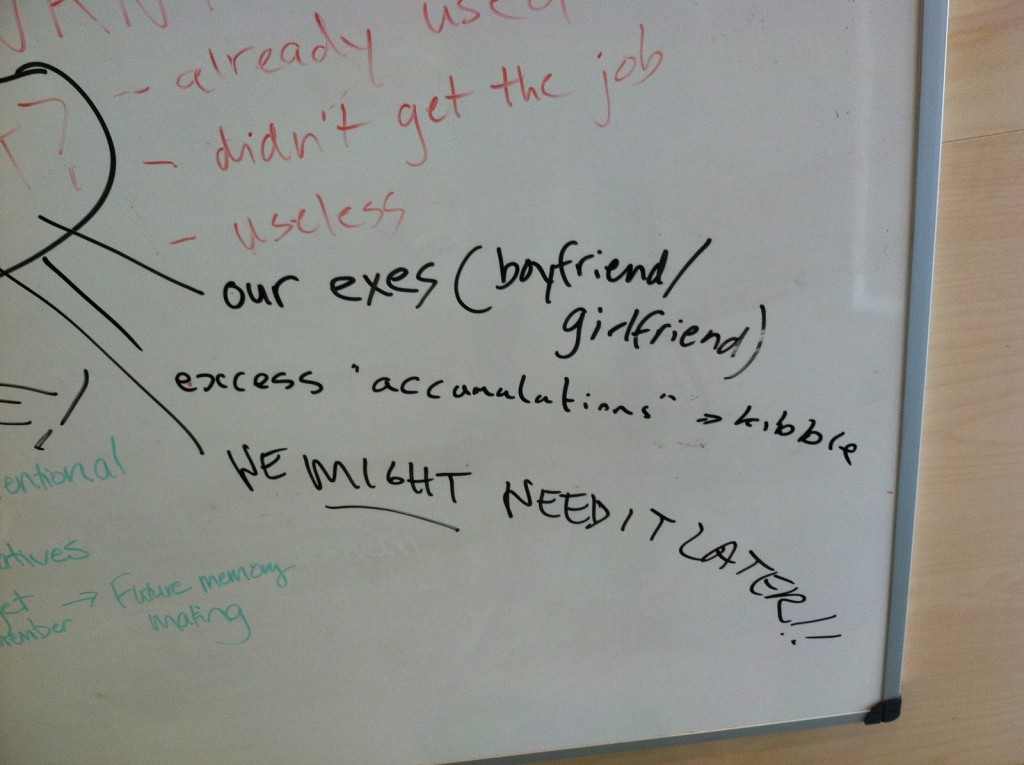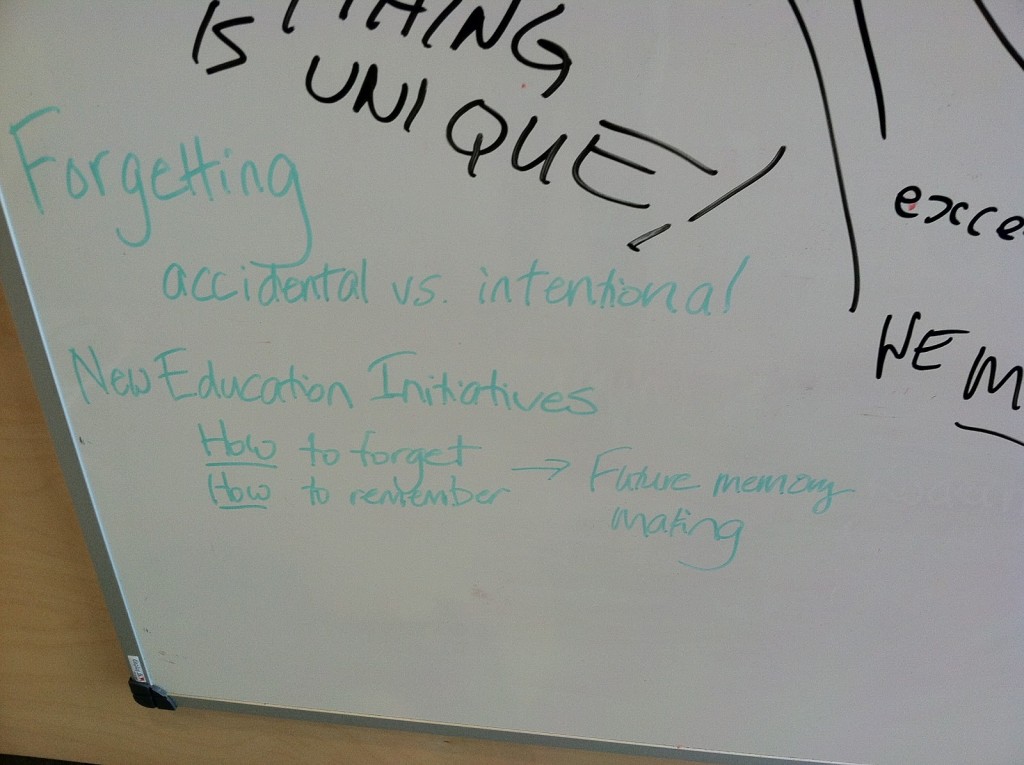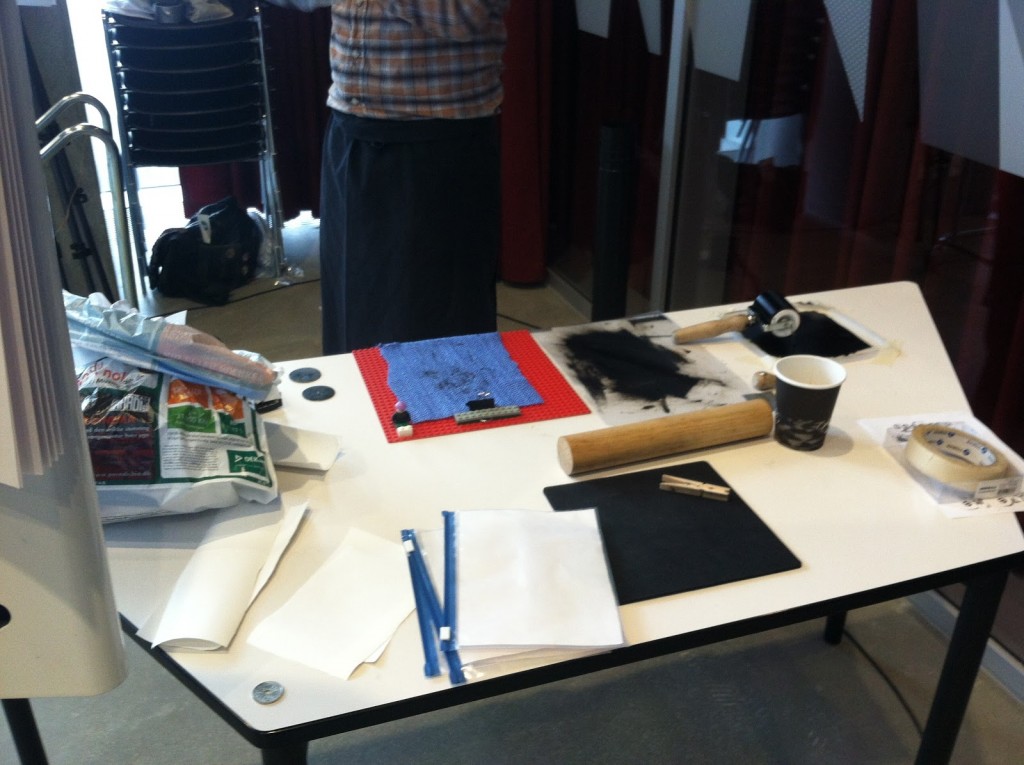This contribution documents the generative method we used to create a two-day public workshop on archiving digital memory, which occurred in April 2016 at the Counterplay Festival in Aarhus. Our group members, collectively known as the Futuremaking group created two distinct experiences. The “Help Desk of the Future” was created as a means of acting out how unhelpful many helpdesks actually are and to imagine how algorithms may be positioning our futures for us. The Museum of Random Memory functioned as a pop-up curatorial event where participants could offer up memories, experiences, and objects that they wished to “forget,” which was subsequently documented by the museum.
We asked each member of the Futuremaking group to share their experiences of the Help Desk and Museum, and posed the question “What is your recollection of our futuremaking?” The responses of the members are shared below.
Original Project Archive:
http://museumofrandommemory.com
http://futuremaking.space/workshop
Response from Futuremaking member Chris Bratton on the Museum of Random Memory
Thursday, April 14th and Friday, April 15th
When I think of the Museum’s founding, I can’t but help recall that all was unfamiliar, a place I’d never visited, the people, none of whom I knew before we gathered on that first morning, and the project, that of future making, which brought us together. It seemed pretty improbable, but pleasant enough — to be elsewhere and free of anything but the vaguest expectations, whether my own or those of the other participants or perhaps most surprisingly the conveners themselves.
I say “surprisingly” because we were a big group, at least 15 or so. Some number of us traveled from Europe and the US. It took alot to bring us together, and to support us over the days we would work together. And the premise was speculative to say the least, without a necessary result, a point emphasized by Annette Markham — that there was no typically defined goal. It was up to us to make it meaningful, to engage with each other, and with those around us, the people and the city itself. There were only questions: What are we now doing that leads to seemingly inevitable futures? What are the processes of memory making? What about the relationship between analogue and digital life? What, in the end, is the future of memory?
It’s difficult to represent the discussion that began on that first day. We were so thoroughly in it, meaning that the group — there were soon to be two working groups — quickly built a rapport and began parsing the issues. The broad differences in our experience found shape in our shared commitment to unconventional, even radical ways of working, particularly collective work. It was all complicated and rapid, improvisational, so the best I can do is stitch together one version from my recollections and the sketches and notes I kept:
( We are preoccupied by the institutional forms of memory and the sedimented processes of selection and exclusion that make cultural, social and political inequality appear commonsensical and natural) Those things that are preserved and valued as “artifacts”, which are organized and locked up, archived.
In contrast to the mute authority of the archive, we live in a riot, a chatter of circulation. Things are everywhere, in their most pervasive forms, as ephemera and trash, degraded, decomposed and uncommented on. (Where are people in their particularity and complexity?)
How to build an archive of the everyday, the numberless things, real and immaterial, in which we live our lives? (We are concerned that it be porous, in a constant state of circulation and meaning-making. What it is now, is not what it was or will be)
We continue by mapping the institutional life-cycle of the archived object: its acquisition, its cataloguing as a singularity in a collection among other collections, its interpretation and exhibition — and finally, its deinstalling, memorializing, and return to the archive — or its “death” in deacquisition.
The language moves from “Museum of Forgetting” to “Museum of Forgotten Futures” and finally becomes “Museum of Random Memory”
The Museum of Random Memory takes what’s excluded — or as it defines it “uselessness” — as its fundamental term. An object, a material thing, a process, an image or an idea, the Museum acquires these things by asking people to select a useless thing, and then represent it by providing a brief statement at the point at which the object enters the collection.
The approach emphasizes an immediate selection, preferably something the person-become- curator is already carrying, detritus, refuse, junk, the unremembered, unwanted and unloved.
Sense comes from the act of remembering. However, the “non”artifact (degraded and decomposed as all forms of trash are whether as objects or rumors, lies, conspiracies, jokes, tales, etc.) is only revealed through an “un” narrating, that is in an indirect appeal to the preconscious — liminal — state of the thing. It is this brief reflection that in our own retrospective reflection on our work, some one among us called the moment of resonance. It’s a felicitous turn of phrase, the moment of resonance, which neatly draws the critical horizon of the project.
The appeal “Give me something useless” …
and the patter:
We are opening a new museum tomorrow and want you in the opening exhibition.
Give me a useless thing.
Text me a useless thought.
Send me a useless photo
Or
An idea
A photo
A thing
You are a curator.
I am a collector.
Saturday, April 16th
It all proceeded quickly, almost effortlessly. There was little conversation about what needed to be done, No one was assigned anything. We immediately divided tasks according to what we knew our ability and talent to be. Maybe it was the fact that we had so little time to our opening, but the entirely improvisational process that began a day earlier with our planning now took on an increased momentum. I think we were startled by how sensible it all was and how pleasurable.
The Museum was physically located in a “room” created by partitions at the far end of the Library, its opening announced by flyers we distributed and a sign at the entrance. The gallery was staffed by a “collector” (rather than curator), “de-installer” (rather than preparator), etc. The collecting proceeded in two forms. People were encouraged to engage directly with the collector, who in turn, explained the project, worked with them to identify their object, then had them fill out the acquisition form. The item, once catalogued, was hung from strings randomly criss-crossing the gallery, a nod to the radical experiments in contingency and exhibition of the Dadaists and Surrealists.
I was also part of a mobile crew with a video camera that roamed the library and collected objects. In our case, we taped the exchanges, which were later uploaded to the MRM site.
When approached about the project of a “new museum”, people were quite seriously interested. As we proceeded with our description that interest also became amusement, typically at the point at which we discussed uselessness. I think that It’s important to emphasize that this only intensified people’s involvement. The exchange took on a game-like quality, We proposed the rules and people took up the challenge and played. This was also true from the exchanges I overheard between MRM “staff” in the gallery and people who entered. It’s also important to note that this was not playing along, rather it was playing in, an investment in a process and the possible discovery it held.
Further thoughts about the museum — a machine for social reproduction, assigning value and meaning to culture and history. What if a museum were not preoccupied with reproduction, but instead representation, history as unfolding meaning? This not a negation as so much as a strategy of cancellation, for example the renaming by way of prefixes, (de-), “deacquisition” form, (im-) “impermanent” collection.
To return to the notion of resonance, the objects were exhibited along with their deacquisition forms as a note on the essential impermanence of the project, but also at some physical remove from each other to encourage the work of connection in viewing each thing, whether object or description. Throughout the opening, viewers/participants/curators lingered over the work, discussing it with “staff” and each other.
New works were acquired and added during the opening. The exhibition came to include the shedding of unpleasant memories: “A card from the job I did not get;” a betting ticket that “reminds me of how much money I lost;” or a drawing of a recurring nightmare of “endless yard mowing.” Other urgent histories live in the detritus of the everyday, of health in an empty foil sheet which once held capsules for when “I had a headache,” and social precarity in a note “I am unemployed and am useless.”
But there are other levels of understanding in the objects and their descriptions, not just sociological and historical knowledge, but psychological and affective experience as well. The expression of melancholy, disaffection and even joy, as in the family who was intent on having their daughters represented in the collection {see item: “Beret (sticky)}.
Or the shedding of things long ago lost … “a girlfriend I once had and the drugs we took together.”
Or the single message on eradicating both “Aryan domination” and the fear of dying in a “falling” airplane, a neat conflation on transcending social catastrophe.
The performance, the installation, the documentation, each became an event and experience in its own right. In the end, what’s left of MRM? There’s the digital half-life in the archived materials, the URLs, the images, the videos, and the frame shots. And then maybe even more important, the analogue trace in Kasper Ostrowski’s archaic prints — rubbings of the actual objects — which serve as a kind of last word, the stubborn material fact of memory.
Afterward
“At some point it became real for people, the things they carried.”
“Forget random things… forcing people to reconcile, to talk about the resonance, the confusion between people and things.”
“The point is very different from the object. I wonder what they would say to each other?”
“This worked so well because of the rituals of care, telegraphing importance.”
“Authenticity. Our experience was present. This was not a parody. It was a displacement and recoding.”
“The temporary/permanent the state of precarity of the Museum itself as mobile and temporary, a recognition that we live in a historical period when precarity is a pervasive condition”
The Museum of Random Memory was founded in April of 2016 in Aarhus, Denmark at the Counterplay Festival as part of Futuremaking, a project on the history of tomorrows.
Responses from Futuremaking members Elyzabeth Holford and Justin Lacko on the Help Desk of the Future
We set up the HelpDesk of Your Future (HDYF) with only two premises: 1) to enact how unhelpful many helpdesks actually are and B) to imagine how algorithms may be positioning our futures for us. With that in mind, here’s our take on the event:
Find Elyzabeth’s disclaimer and Justin’s manual in PDF format here:
Disclaimer: http://www.takaji.ca/store/futuremaking/HDYF%20Disclaimer.pdfManual: http://www.takaji.ca/store/futuremaking/Helpdesk%20of%20the%20Future%20(BID%20Series%20A).pdf
Or, view the images below:
Response from Futuremaking member Andrew Sempere on the Museum of Random Memory
A GOOD MEMORY
I consider myself to have a good memory. I can recall, in a dreamy way, my second birthday. But increasingly I find myself constructing memories more consciously, reviewing my notes, checking my calendar, flipping through the pictures on my phone. My memory is like a trail now, spread out across internet services and files and devices. Last week I uncovered a smartphone abandoned in the back of a drawer and realized it contained about a year of images, some things I wanted, some I wanted to delete but most just there along with a handful of accidental shots. The metaphor some might use is of opening a lost storage room but these are stranger: a storage room is filled with the deliberately placed, these photos are artifacts of things that I have no memory of. These are proof of the existence of empty rooms, the shoes I was wearing on a particular tuesday, the lunch I ate in January of 2013. They are proof that I was alive and holding a device at a particular time. They are not: proof that I was paying attention, proof that the moment mattered, proof that anyone cares. In spite of this, the images are all presented with the same weight by the devices, the same resolution, the same quality, the same interface. It’s my own ability or inability to construct them into a narrative that gives them a weight.
A RECONSTRUCTED MEMORY
I was on my way to do this for this project – to review my records of the week and the events, to reconstruct what happened when we put together our museum – and then I decided to write blind instead, relying on what’s in my head alone. It’s annoying me, honestly. There’s a nagging feeling here. I am physically itching to reach for the folder that contains the images. I’m cheating, flipping through the handful of pictures we’ve posted to the shared doc where we are writing this text together. I’m trying not to read the other narratives there, but I’m skimming them anyway. My brain wants to make sense of what I remember, make an order to the chaos, make an agreement with my cohort.
This isn’t something new, this reconstruction of memory: it’s a fundamental thing that humans do when we build culture: we re-tell narratives again and again, reinforcing the parts that are weak, smoothing over the holes, filling in the gaps. When an event is particularly traumatic or joyful we retell it over and over again to anyone who will listen because this solidifies the truth, digs the record groove a little deeper, turns the experience into reportage and makes something ineffable into a foundation on which we can build. When we don’t do this, or avoid doing it, our brains might do it anyway, replaying the unbidden and forcing our pattern-matchers to match with or without our will.
FITNESS FOR COMMERCIAL PURPOSE
A weird incoherence has emerged: this old method of oral tradition, of collectively reliable but individually unreliable memory forming a truth when taken together, has taken form on the internet. In this version, the public is replaced with publics, and a thousand agoras exist: these are at once empowering and isolating. The notion is as old as humanity but with the following characteristics: 1. The public squares no longer require the commitment of moving through physical space. They are easier and faster to access, and nothing (including the very humanity of the speaker) can be assumed. 2. The internet promises a permanent record, more data than we want, more details, more metadata. We record everything and let god sort it out later, because in fact recording is easier than forgetting. Recording can be done without identity, but forgetting requires ownership: I must single out a memory, an artifact or an idea and erase it, that very one and not the others, while the technology, as the myth goes, is blind to meaning, simply collecting what it encounters without judgement, politics or care.
In the beginning the network was the agora, and the agora was problematic. A free space with no rules, we then relinquished ownership of the infrastructure to commercial interests in a circle: keeping a space clean and well lit costs money, funded by advertisers who want to reach the people, who will gather in clean well-lit spaces and accept the advertising as the cost of interchange. Once the novelty wears off (and it always does) what remains are the memories and the artifacts of the memories, and these are locked tight, forming the walls of the space. Here the systems demand memory because they are built of it: unbidden memory palaces, an ossification of history with or without our will.
But architecture always impacts its inhabitants and agoraphobia sets in. By shifting our social activities to commercial space, they take on a different quality: we struggle with the collapse of the signifiers between high and low culture. Our new myths are interlaced with pop-up ads and sponsored content, login boxes and sound effects. We incorporate cinematic and fictional vocabulary into our everyday lives: we adjust the lighting, apply color grading, add soundtracks. We get better at writing fanfiction about ourselves and our friends. We construct narratives deliberately and we subject them to metrics and we measure their impact and we adjust. This labor makes human life appear as disposable as a hollywood blockbuster, underscored by a technology that whispers that the data is infinite, even while the weight of an event’s significance, recorded on our phone or not, remains as heavy as historic record.
TRUST FALL
The Museum of Random Memory was for me an exercise in ceremonial forgetting, made wonderful by the contrast of the formation of new memories from having recently just met my fellow museum staff. The genius of the project was in the selection of the team and the danger of doing things out of order: We designed and built a project before we knew each other, and we documented the project before we had designed a thing. The emphasis was therefore on creating a potential energy without fully knowing the consequence of the outcome. For the players of this particular game this required a special kind of trust, a feeling that whatever happened was the right thing, and whoever took on the role they played did it because that’s what they were there for.
This type of emergent behavior is rare and wonderful but not in itself surprising: given a small carefully selected group of individuals and a specific time frame, you can manufacture the ideal conditions of play. It doesn’t always run so smoothly, but what was more surprising was the degree to which we were able to expand the circle to include a random public. Our museum was nothing without the gifts of our visitors, who took our narrative and ran with it, both showing us what our museum could do and telling us what the museum was for.
PLEASE FORGET
I believe the importance of the museum emerged from a particular strategy of honoring the meaning of the objects in our collection over the infrastructure of the museum itself. Most physical museums and online social networks provide a rock-solid framework and the promise that they will always exist. They are machines for preservation. This is a useful fiction of course, but it does mean that the content such systems hold is de-emphasized in favor of the framework itself. The dominant, commercial agoras which occupy most of our social interactions ask for your most intimate and significant memories and then trivialize them in order to render them available for broader use. Such systems transform family photos into stock art, birthdays into calendar reminders and late night confessions into fodder for surveillance. Nothing that you actually care about matters much to the entities that hold culture in this way, and yet participants are also not permitted, by design, to export any of these memories: they are locked in the walls. By emphasising a ritual of forgetting, by declaring our labor in service of the useless, we flipped the narrative.
Your photo of your vacation is one of a million vacations. It is valuable only as a drop in the ocean of data. Trivialized in this way, the image is stripped of meaning and free to be instrumentalized. In contrast, our framework was explicitly temporary, built of plastic bags and string and paper, intentionally destined for destruction. Our museum was worth nothing in a commercial sense, and what this did was leave room for the items in the collection to take their place as meaningful. Not any vacation photo, but this vacation photo, the one I wish to forget. Not any receipt, but this receipt, this memory of regret I no longer want to carry.
In an era where everything is archivable, we archive nothing. Photographs, texts, music, songs and ideas are free and plentiful and so disposable. At the same time we have opened archives up to audiences for which they were never intended: individual significance is erased in favor of a notion of the greater good. This tension between the dissolution of The Public while exposing the intimacies of smaller publics for broader consumption defines our age. Data is not data, it is someone’s memory, and to remain relevant it cannot be frozen or exposed so quickly: our memories must remain mutable, alive, erasable and fragile, potential fuel for the open and shut process that creates culture. Am I an unreliable narrator? Does this contain contradictions? Very well then.
Response from Futuremaking member Ramona Dremljuga on the Help Desk of the Future
Where did we start from?
We agreed that a lot of trash is being created in every level of our lives. Even if we consider specific details unworthy of being noticed, kept or commented by yourself or others (unless you’re unique), they exist. Somewhere, somehow, with different settings of accessibility. What does it mean? Why should we care? Should it be done differently?
For example, no-one knows – really – what happens to people when they stop being, at least mentally. Physically (or physiologically?) we can imagine or if we are very eager, we could also see that there’s a natural process that takes place and that most of us just aren’t paying much attention to. We choose not to; We don’t have a need for it (again – unless you’re unique).
Things, moments, emotions and actions – they have a lifespan as well, including an afterlife. Similarly to physical bodies, they are left somewhere. Do we acknowledge where and how? When do we come to pay attention to them or try to recollect their location? If we do, what would be the reasons to start wondering when did something start, how did it come to exist, and why did it stop or end?
What is it we did and experienced?
The process of our helpdesk for the future. Everything done the opposite way of how it should be happening. Controlled, but by whom? Literacy issues. Absurd situations with real data. Possibly real consequences – how would you know? How do you control something you cannot see? How do you react to the information about you that is not really about you but still gets served as if it were? How would others know? I’d say, it’s all a matter of practice.
Response from Futuremaking member Dalida María Benfield on the Museum of Random Memory
Collective Re-search/We search
Making things, doing research, and being together. How do we do all of this at once? How do we think about each other while we’re also “making”? How can our “research” and our “making” be accountable to each other, in process, relational?
During the initial launch of the futuremaking projects that resulted in the Museum of Random Memory and the Help Desk of Your Future, the sense of being together, as researchers, artists, and teachers, was just as important as our sense of accountability to the requirement that we create a meaningful experience for our participants, who came to us via the “CounterPlay” conference, and the multiple publics of the space, DOKK1, a new public library in Aarhus, Denmark.
Annette Markham, Professor at Aarhus University and founder of the futuremaking.space, took advantage of the CounterPlay festival to launch the first of what is envisioned as a series of numerous gatherings of researchers to engage in new forms of transdisciplinary convenings and events. The festival gave us a physical site, an audience, and a limited amount of time in which to think, produce, and engage.
DOKK1 itself is an extraordinary architectural and social space; posing as both a public library, a town hall, and an exhibition and performance space. Because of its very recent opening, I felt challenged and super excited by the potential of the space. The space asked us to fulfill its promise of democratic, horizontal knowledge sharing. This question dovetails with the question of horizontal knowledge that has preoccupied the trajectory of my research and practice as an artist: Whose knowledge is important? What should be saved? What is left out? What forms should the archivization of important stories that have not yet been recorded take?
During our first day, we got to know each other; as you can see in the timelapse, Annette asked us to rotate from an inner circle to an outer circle, talking to each other quickly, introducing the key nodes of our current practice. This happened with such intensity precisely because we knew that within about 48 hours, we would be inviting others into the space, with a project that we hoped would be as dynamic, and feel as necessary, as this introductory exercise.
Critiquing the archives
We were arbitrarily divided into two groups; each working on a different manifestation of a “playful” posing of crucial questions regarding ethics and big data. While our colleagues in the other group developed the ideas that would become “The Helpdesk of Your Future,” we began toying with the idea that the data being collected about us, is, in the end, mostly irrelevant.
The contradictory ideas that we all have important knowledge to share, but also that many of the forms of knowledge that are being preserved for posterity might actually be unimportant, fused for us in the idea of The Museum of Random Memory (MORM). What’s important? Who decides? What if what’s actually NOT important is what is remembered, about each of us, in its very specificity and contextualization in the complex narratives of our lives?
The ephemera that is collected about us by digital archives contain random memories, the understanding of which might be forever locked away in…well, random memory. How might we institute our agency in the (de)curation of our random memories? How might we “see into the future” to decide what always/already/would be “random”?
To formulate the structure and procedures of our institution, we researched the strategies of other temporary and mobile museums, as well as other small museum processes.
A GLOSSARY OF THE MUSEUM OF RANDOM MEMORY
(De) Collect: MoRM is a collection of lost objects — useless ideas, photos, and things — hardly seen, unloved and unwanted, the ether of the everyday.
(Un) Curate: MoRM is a meaning machine entirely driven by radical dispersal and sharing.
(Dis) Conserve: MoRM is a practice of the ephemeral, a shadow box of traces and after-images, where a recalcitrant past is made to serve possible futures.
(A) Educate — MoRM is a place of unending, generative contest.
A Note on Methodology (Our Big Data Problem): Categories of analysis, creating our own
- Affect
- Inspiration
- Markers
- Annoyances
- Multiple/Conflicting modes of analysis
The glossary of processes generated the necessary institutional structures of the “museum,” which became a performative arena for the acquisition, exhibition, and analysis of the forgotten and useless “data”:
COMPARTMENTS OF ACTIVITIES DURING THE TWO DAYS OF THE MUSEUM
Acquisitions
Intake Desk
Questionnaire
Cataloging submissions
Collections
Public participants
Virtual; Narrative; Material
Curations
Mobile Team
Intake Desk
Design
Flyer/call for contributions
Structural concept
Signage
(Dis) Preservations
Object de-archiving/restructuring with empirical printmaking
Invitation Period
Open call for submissions
Open ended
Museum Construction
Materials assembly
Spatial arrangement
Collaborative construction
Museum Opening
Public opening 13:30
Wine, cheese, & crackers
Guest interaction
Continued acquisitions
Museum Closing
Archiving of material collection
De-structuring of space
Online presence
Low fi web design
Ephemeral
Website archived post-museum closing
Uncollecting
The process of (un)collection for MoRM became its central fabric of engagement. As we gathered, in person and through social media, our collection of “useless” and “unwanted” memories, we asked each contributor to take on the role of future curator of their collection of random memories.
In person, we spread out around the space of DOKK1, engaging in many different and alternately amusing, saddening, bemusing, and confusing conversations with our contributors. The collection process occurred throughout the physical spaces of DOKK1, including participants in the CounterPlay festival and the general public who were using the space for reading, studying or other gatherings. We also collected artifacts for the collection online, on twitter with the hashtag #randommemory, and our own lo-fi site, http://museumofrandommemory.com.
Rather than being a curatorial process that sought to sort priorities, creating a hierarchy of important people, places, or events, our curatorial process sought out the unimportant, the deprioritized. All people became contributors; and all people became co-curators. We made playful museum staff badges, that we freely handed out to anyone who wanted to play along.
Our collection process produced a series of performative bureaucratic procedures, including an intake form that asked anonymous contributors: What is this idea, photo, or thing? Where did you get it? Why did you forget it, or what are you willing to forget it? In conversation, these questions expanded to include: Why did they wish to de-accession it? What was it they wanted to forget; or, what did it make them remember?
Pedagogies of ephemeral knowledge
The meanings of small objects, of ephemera, and the texture of our everyday lives, emerged in our conversations with contributors, each other, and visitors to the museum. We found that access to the intimate details of people’s lives is made extraordinarily easy through the small things they carry in their pockets, purses, briefcases, and backpacks. These details open onto shared experiences. They are conversation starters. The opening of these meanings in conversation with a “random” collector/curator, of a “museum” of “random memory” initiated new constellations of relationships, mappings of life-worlds, and, with the playfulness of the process, a new sense of rhizomatic interconnection.
Items such as pens, receipts, dog treats, business cards, and empty pill packages; images that we didn’t know were even on our phones; ideas that are “useless” that a contributor would come up with spontaneously; all of these were part of the MORM “Temporary Permanent” collection. The collection was lovingly catalogued, numbered, in our (Dis)Acquisitions Department.
The collection was displayed, along with identification tags and numbers, during the museum’s opening – featuring the requisite wine and cheese – and exhibition, lasting two hours. The collection expanded during this time as well, with spontaneous contributions accepted throughout. To the left of the space was the MoRM; and to the right, the Help Desk of Your Future. Most participants attended both spaces/experiences; and were quite relieved to “escape” the dystopic future of the helpdesk to the weird randomness of the MoRM.
The quotidian nature of the collection was sustained by an installation approach that relied on everyday materials; plastic bags “preserving” the items, and hung on string, criss-crossing the space. The De-Acquisitions forms, which were also displayed, provided context for the collection, imbuing each artifact with its ephemeral history. Supplementing this information was a video reel documenting some of the processes of (un)collection. These stories began to make patterns, and in response, our Data Analysis spontaneously began to take shape.
Some of the trends that emerged included: Forgetting as an act of healing, in relation to a traumatic event. A business card from a job that one didn’t get; a scrap of paper that reminds one of an ex-lover. Items whose usefulness had simply been spent, including a used ticket to a museum or train or concert, or packaging for a pill or a candy. There was an overarching sense of discovery in the process of well; of things that we didn’t know we had, and therefore were more than willing to de-accession. This was particularly true of mobile phone images, some of which can be found on our archive or on our twitter account (which continues retweeting random tweets hashtagged #randommemory).
In the horizontal information sharing made possible by the museum, the question of pedagogy – a pedagogy of forgetting, a pedagogy of remembering – emerged as a future education initiative. Is it possible that we have forgotten how to forget? Is it possible that we have forgotten how to remember? If so, what would we need to learn to forget and remember?
(Dis)archivization
Why would we want to forget random ideas or things? To erase our stories or to create the possibility for being remembered in a self-authored way? Each object that was de-accessioned in our Museum of Random Memory had a story that was shared with us, even if it was a story of non-remembrance. Its story also unfolded in the conversations that we had with each other, and that our visitors had with the collection.
The multiple visualities of each object – the cultural spaces, modes of production – evoked, ultimately, the habitus of each contributor. With the paradoxical invitation to give us something they wished to forget, we also invited them to remember this moment of forgetting. Creating a stage for memorializing forgetting, the MORM created the possibility for a playful experience through which we might better understand how the current state of digital data gathering, with its simultaneous anonymity and singularity, operates.
Our digital traces, random as they are, do tell stories. These stories can be creatively shaped in conversation with each other, as MORM created an opportunity for; yet, they can also, map our locations, our relationships, our consumption.
Rather than map or make too much “sense” of, our final interaction with each item in the collection was to make an imprint of it of it in the Department of (Dis)Preservation.
Literally rolling ink over the item, it was imprinted on paper. The prints now endure, in their plastic bags, as negative space documents of the forgotten artifact. As (dis)archivists, we are safeguarding these intentional and accidental moments of forgetting for future exhibition.
Response from Futuremaking member Elizabeth Whitney on the Museum of Random Memory
When I fantasize about shedding my skin and reinventing myself in a new career, I imagine life in a library: a large, open space that welcomes public interaction through community engagement. So it was a lovely realization of this fantasy to be invited to participate in the Future Making Workshop at DOKK 1 in Aarhus, to collaborate with a new group of creative colleagues.
The view from The Museum of Random Memory at DOKK 1
This was an unexpected opportunity, resulting from a chance encounter with Annette Markham when she spoke at the University of Turku where I was a visiting scholar for a year. Annette invited me to the two day Future Making workshop/brainstorming event as a means of gathering together like-minded researchers. The workshop was a challenge event, to see what we might produce with a quick deadline and a sparse set of guidelines. We were charged with creating a workshop for the public as part of the 2016 Counterplay Festival, based on themes of future and memory.
On a tour of Aarhus Godsbanen artist live/work space
My partner and I arrived late—it was a complicated trip to make from our little city in Southwestern Finland. We joined the group of creative scholars around a table, in the middle of a conversation about practices of archiving and cataloging memory, both in institutions and in our personal lives. Immediately on entering, we were handed small brown notebooks and offered an array of craft materials, including stamps, markers, and colored pens. Creative outlets facilitate brainstorming, and in this case, they also allowed for a rapid immersion into the environment. Within minutes of introducing ourselves, we traded stamps back and forth, sharing a search for the right color of marker with which to illustrate our thoughts.
Brainstorm central
From here, the time flew, punctuated by food and wine and more food and wine, and conversations about jobs and travel and artistic academic endeavors. In between, we managed to be impressively productive. Actually, there was no in between. The eating and drinking and conversing and notebooks and stamps and crafts were all part of the flow of our time together, and all equally important in how we worked and what we produced.
Enthusiastic collegiality at a Counterplay Festival dinner
Our workshop organically divided into two groups—we planned to build two separate, interactive installations. My group was the Museum of Random Memory, an archive of public memory that included a website and a living installation by and for the public who attended the Counterplay festival. Our archive, like the material it housed, was designed to remind of us of the things we had forgotten.
Mapping The Museum of Random Memory
Festival participants offered us the ephemera of their lives. They pulled from their pockets ticket stubs, worn coins, even balls of lint. We catalogued each one and included it in our DIY installation so that they could return and see their lives on display. Participants were also invited to submit images via their phones that were housed on our website, through a random image generator.
At the museum opening
When it comes to our archives, we are unsure about what to catalogue. What should we keep, and what should we throw away? To what extent is value determined by our own investments, and to what extent does it depend on memories shared with others?
How fitting to be considering these questions in a library—and one of the most highly rated public libraries in the world. A library’s purpose is to archive and house materials, both in house as well as, increasingly, in virtual worlds. Libraries encourage us to explore the limitlessness of the archive, as well as the limits of what we can contain. The Museum of Random Memory illustrated the ways in which we can access our experiences like a database in a random generator mode. These collections shift when they merge in public space, as they did during the Counterplay festival. Ultimately, our archives of memory are as mercurial as we allow them to be.
Response from Futuremaking member Mads Rehder on the Museum of Random Memory
1 workshop – 4 days – 13 institutions – 20 people
How are we making future memories and what does a future making perspective entail for the way we think about time, presence and everyday life?
The French phenomenologist Maurice Merleau-Ponty insists on thinking about the bodily perception of the present when dealing with issues of memory and time.
“When I call up a remote past, I reopen time, and carry myself back to a moment in which it still had before it a future horizon now closed, and a horizon of the immediate past which is today remote.” (Merleau-Ponty, 2005, p. 483)
The mentioned closed horizon describes how the future horizon is no longer open when we are looking back at a previous present. Decisions were made and actions taken which have created the memories we are now looking back at. The first day of the workshop we had that open horizon not knowing what to expect. What we now know in the present, is that the experimental workshop concerning future making was a huge success. Thinking about time and memories in connection to the closed horizon of the future is interesting and inspiring methodologically. A way to capture the always passing present can be done in various ways. In this case, visual methods were used and from editing the collected material a video was created which emphasize some of these open future horizons where future memories are shaped.
Already on the first day we sat out to build a workshop which would be based on the discussions and brainstorms happening in the hours we would spend together. The day started in silence. As a group of people who did not know each other we were given the assignment to build and rearrange the space in which we would be working for the next four days. After this first long period of time, with only bodily interactions and collaboration without any verbal communication, we were told to form a circle and do an “academic speed date”. In this we were asked to present ourselves and explain why we thought we had been invited to this workshop and how we imagined our own contribution to it. Finally, we all gathered around the large table and began talking about the concept of creating future memories. We were all scribbling in notebooks in an intense atmosphere of curious creativity, trying to transform the abstract thoughts and ideas into a concrete workshop that people would be able to attend the next day. We thought about the present, our memories, and the process in which they are created. As professor Annette Markham said: “Memory: not how it ends up looking, but how we are creating it…”
In the video, I will show a few glimpse of the creative process that took place when people from different institutions, disciplines and parts of the world came together to think about and work on how we as individuals and societies are “Creating Future Memories”. The result of this idea and workshop, was a collaborative, creative and cross-disciplinary atmosphere in which we ourselves created these future memories.
